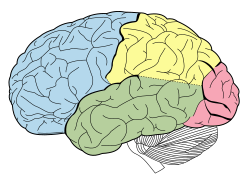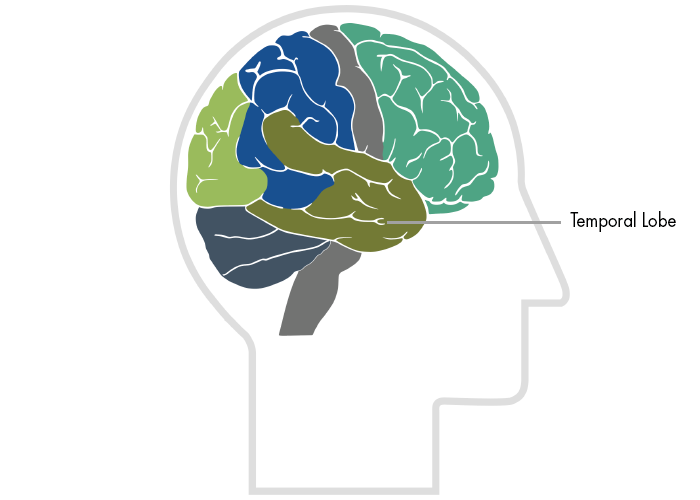The temporal lobe is one of the four major lobes of the cerebral cortex in the brain of mammals. The temporal lobe is located beneath the lateral fissure on both cerebral hemispheres of the mammalian brain.
The temporal lobes are involved in the retention of visual memories, processing sensory input, comprehending language, storing new memories, emotion, and deriving meaning.
Structure

Medial temporal lobe
The medial temporal lobe consists of structures that are vital for declarative or long-term memory. Declarative (denotative) or explicit memory is conscious memory divided into semantic memory (facts) and episodic memory (events). Medial temporal lobe structures that are critical for long-term memory include the amygdala, brainstem, and hippocampus, along with the surrounding hippocampal region consisting of the perirhinal, parahippocampal, and entorhinal neocortical regions. The hippocampus is critical for memory formation, and the surrounding medial temporal cortex is currently theorized to be critical for memory storage. The prefrontal and visual cortices are also involved in explicit memory.
Research has shown that lesions in the hippocampus of monkeys results in limited impairment of function, whereas extensive lesions that include the hippocampus and the medial temporal cortex result in severe impairment.
Function

Visual memories
The temporal lobe contains the hippocampus and plays a key role in the formation of explicit long-term memory modulated by the amygdala.
Processing sensory input
- Auditory
- Adjacent areas in the superior, posterior, and lateral parts of the temporal lobes are involved in high-level auditory processing. The temporal lobe is involved in primary auditory perception, such as hearing, and holds the primary auditory cortex. The primary auditory cortex receives sensory information from the ears and secondary areas process the information into meaningful units such as speech and words. The superior temporal gyrus includes an area (within the lateral fissure) where auditory signals from the cochlea first reach the cerebral cortex and are processed by the primary auditory cortex in the left temporal lobe.
- Visual
- The areas associated with vision in the temporal lobe interpret the meaning of visual stimuli and establish object recognition. The ventral part of the temporal cortices appear to be involved in high-level visual processing of complex stimuli such as faces (fusiform gyrus) and scenes (parahippocampal gyrus). Anterior parts of this ventral stream for visual processing are involved in object perception and recognition.
Language recognition
The left temporal lobe holds the primary auditory cortex, which is important for the processing of semantics in both speech and vision in humans. Wernicke's area, which spans the region between temporal and parietal lobes, plays a key role (in tandem with Broca's area in the frontal lobe) in speech comprehension. The functions of the left temporal lobe are not limited to low-level perception but extend to comprehension, naming, and verbal memory.
New memories
The medial temporal lobes (near the sagittal plane) are thought to be involved in encoding declarative long term memory. The medial temporal lobes include the hippocampi, which are essential for memory storage, therefore damage to this area can result in impairment in new memory formation leading to permanent or temporary anterograde amnesia.
Clinical significance

Unilateral temporal lesion
- Contralateral homonymous upper quadrantanopia (sector anopsia)
- Complex hallucinations (smell, sound, vision, memory)
Dominant hemisphere
- Receptive aphasia
- Wernicke's aphasia
- Anomic aphasia
- Dyslexia
- Impaired verbal memory
- Word agnosia, word deafness
Non-dominant hemisphere
- Impaired non-verbal memory
- Impaired musical skills
- Prosopagnosia
Bitemporal lesions (additional features)
- Deafness
- Apathy (affective indifference)
- Impaired learning and memory
- Amnesia, Korsakoff syndrome, Klüverâ€"Bucy syndrome
Damage
Individuals who suffer from medial temporal lobe damage have a difficult time recalling visual stimuli. This neurotransmission deficit is due, not to lacking perception of visual stimuli but, to lacking perception of interpretation. The most common symptom of inferior temporal lobe damage is visual agnosia, which involves impairment in the identification of familiar objects. Another less common type of inferior temporal lobe damage is prosopagnosia which is an impairment in the recognition of faces and distinction of unique individual facial features.
Damage specifically to the anterior portion of the left temporal lobe can cause savant syndrome.
Disorders
Pick's disease, also known as frontotemporal amnesia, is caused by atrophy of the frontotemporal lobe. Emotional symptoms include mood changes, which the patient may be unaware of, including poor attention span and aggressive behavior towards themselves and/or others. Language symptoms include loss of speech, inability to read and/or write, loss of vocabulary and overall degeneration of motor ability.
Temporal lobe epilepsy is a chronic neurological condition characterized by recurrent seizures; symptoms include a variety of sensory (visual, auditory, olfactory, and gustation) hallucinations, as well as an inability to process semantic and episodic memories.
References

External links

- The medial temporal lobe memory system
- H. M.’s Medial Temporal Lobe Lesion: Findings from Magnetic Resonance Imaging







0 comments:
Post a Comment